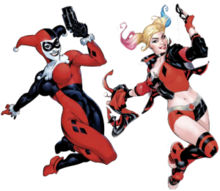
Back هارلي كوين Arabic Harley Quinn AST Харли Куин Bulgarian Harley Quinn Catalan Harley Quinn CEB Harley Quinn Czech Harley Quinn German Χάρλεϊ Κουίν Greek Harley Quinn Spanish Harley Quinn Estonian
| Harley Quinn | |
|---|---|
 The classic and modern iterations of Harley Quinn. Art by Terry Dodson. | |
| Publication information | |
| Publisher | DC Comics |
| First appearance | Batman: The Animated Series "Joker's Favor" (September 11, 1992) |
| First comic appearance | The Batman Adventures #12 (September 1993, non-canon) Batman: Harley Quinn #1 (October 1999, canon) |
| Created by | Paul Dini (writer) Bruce Timm (artist) |
| In-story information | |
| Alter ego | Dr. Harleen Frances Quinzel[1][2] |
| Species | Human |
| Place of origin | Brooklyn / Gotham City |
| Team affiliations | Suicide Squad Gotham City Sirens Quinntets Gang of Harleys Secret Six Justice League of Anarchy Batman family[3] |
| Partnerships | Joker Poison Ivy Bud and Lou Catwoman Batman Deadshot Janet Mitchell The Carpenter |
| Notable aliases | Holly Chance[4] Dr. Jessica Seaborn[4] |
| Abilities |
|
Harley Quinn (Dr. Harleen Frances Quinzel) is a character appearing in American comic books published by DC Comics. She was created by Paul Dini and Bruce Timm for Batman: The Animated Series as a henchwoman for the Joker, and debuted in its 22nd episode, "Joker's Favor", on September 11, 1992. While intended to appear in one episode, Quinn became a recurring character within the DC Animated Universe (DCAU) as the Joker's sidekick and love interest, and was adapted into DC Comics' canon seven years later, beginning with the one-shot Batman: Harley Quinn #1 (October 1999). Quinn's origin story features her as a former psychologist at Gotham City's Arkham Asylum who was manipulated by and fell in love with the Joker, her patient, eventually becoming his accomplice and lover. The character's alias is a play on the stock character Harlequin from the 16th-century Italian theater commedia dell'arte.
Following her introduction to the comics in 1999, Harley Quinn was depicted as the sidekick and lover of the Joker as well as the criminal associate and best friend of Poison Ivy. Later stories depicted Quinn as an independent supervillain who has left her abusive and codependent relationship with the Joker behind, beginning with the publication of her ongoing series, Harley Quinn. After years of scarce appearances in comics, Quinn returned in a leading role in 2009 with the Gotham City Sirens series, as part of an unstable alliance with Poison Ivy and Catwoman. In 2011, DC's line-wide reboot The New 52 reintroduced Quinn in the relaunched Suicide Squad title, which changed the character's personality, design, and origin, replacing her original jester costume with a revealing ensemble and depicting her to be darker than her earlier counterpart. The character took a lighthearted and humorous direction with her second ongoing series in 2013, written by Amanda Conner and Jimmy Palmiotti, which features the character moving to her hometown of Brooklyn and starting her own life in Coney Island. The character has since been depicted as an antihero independent of the Joker and a recurring core member of the Suicide Squad, with Poison Ivy becoming her primary romantic interest.[5] In 2021, DC's line-wide Infinite Frontier relaunch brought Quinn back to Gotham City and reestablished her as a superhero seeking redemption for her past actions.
Harley Quinn's abilities include expert gymnastic skills, proficiency in weapons and hand-to-hand combat, complete unpredictability, immunity to toxins, and enhanced strength, agility, and durability. Quinn often wields clown-themed gag weapons, with an oversized mallet being her signature weapon. Additionally, she has a pair of pet hyenas, Bud and Lou, who sometimes serve as her attack dogs.
Harley Quinn has become one of DC Comics' most popular and profitable characters and has been featured in many of DC's comic books and adapted in various other media and merchandise. DC Comics Publisher Jim Lee considers Harley Quinn the fourth pillar of DC Comics' publishing line, behind Superman, Batman, and Wonder Woman.
Originally voiced by Arleen Sorkin in the DC Animated Universe, she has since appeared in many other DC projects voiced by actresses such as Tara Strong, Hynden Walch, Laura Bailey, Jenny Slate, Melissa Rauch, Laura Post, and Kaley Cuoco; the latter provided the character's voice in the 2019 animated series Harley Quinn. Mia Sara portrayed the character in the 2002 television series Birds of Prey. Harley Quinn made her live-action cinematic debut in the DC Extended Universe (DCEU) film Suicide Squad (2016), where she was portrayed by Margot Robbie. Robbie reprised her role in Birds of Prey (2020) and The Suicide Squad (2021), with elements of her portrayal's design consequentially incorporated into comics. Lady Gaga will portray the character in Joker: Folie à Deux (2024).
- ^ Barba, Shelley E.; Perrin, Joy M., eds. (2017). The Ascendance of Harley Quinn: Essays on DC's Enigmatic Villain. Jefferson, North Carolina: McFarland. p. 204. ISBN 978-1476665238.
- ^ Gitlin, Martin; Wos, Joseph (2018). A Celebration of Animation: The 100 Greatest Cartoon Characters in Television History. Lanham, Maryland: Rowman & Littlefield. p. 114. ISBN 978-1630762780.
- ^ McGuire, Liam (August 10, 2021). "Harley Quinn Is Officially Part Of The Bat-Family, DC Confirms". ScreenRant. Retrieved August 20, 2021.
- ^ a b Harley Quinn (vol. 1)
- ^ Knight, Rosie (May 22, 2019). "Brilliant Women of Batman: Harley Quinn Comes Into her Own". DC Comics. Retrieved March 4, 2021.
© MMXXIII Rich X Search. We shall prevail. All rights reserved. Rich X Search